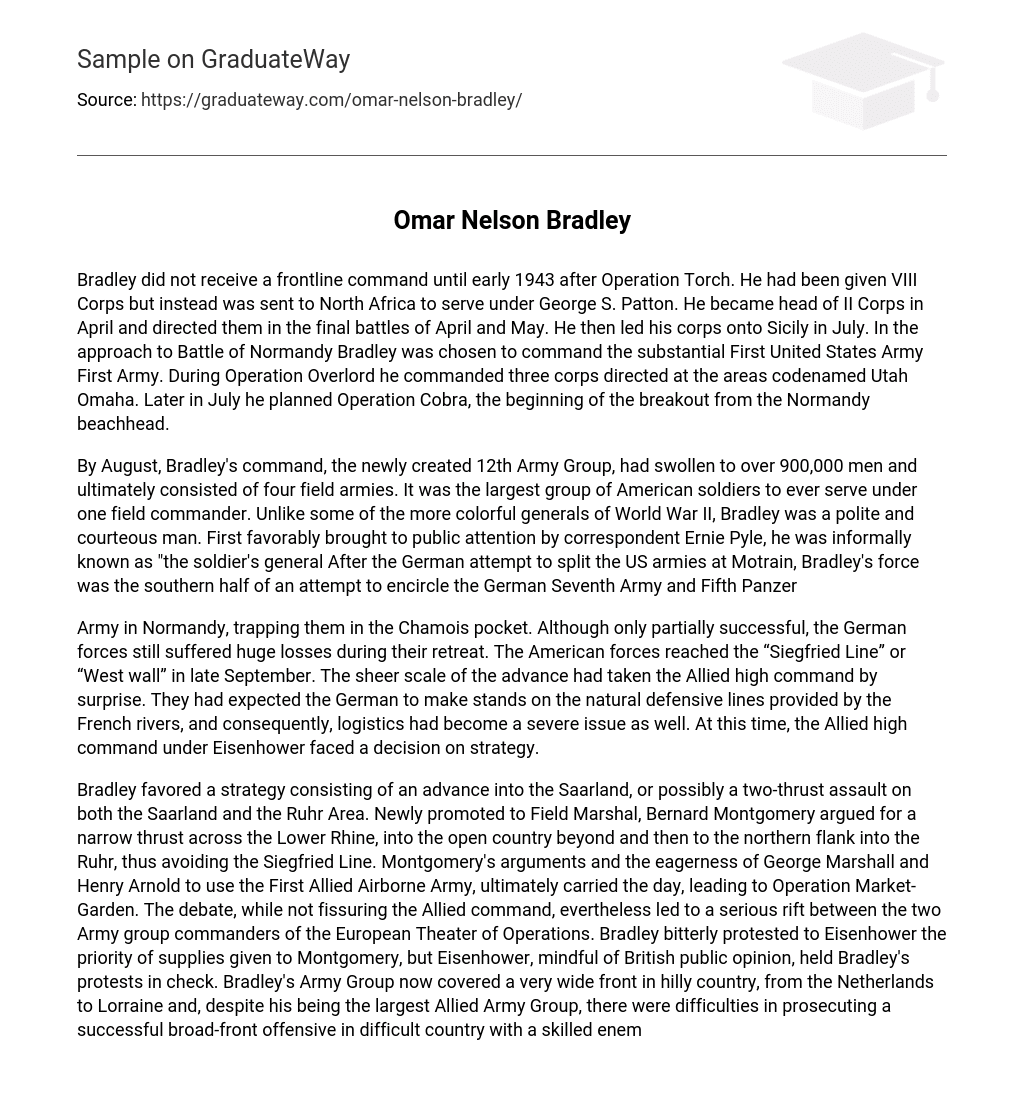Bradley did not receive a frontline command until early 1943 after Operation Torch. He had been given VIII Corps but instead was sent to North Africa to serve under George S. Patton. He became head of II Corps in April and directed them in the final battles of April and May. He then led his corps onto Sicily in July. In the approach to Battle of Normandy Bradley was chosen to command the substantial First United States Army First Army. During Operation Overlord he commanded three corps directed at the areas codenamed Utah Omaha. Later in July he planned Operation Cobra, the beginning of the breakout from the Normandy beachhead.
By August, Bradley’s command, the newly created 12th Army Group, had swollen to over 900,000 men and ultimately consisted of four field armies. It was the largest group of American soldiers to ever serve under one field commander. Unlike some of the more colorful generals of World War II, Bradley was a polite and courteous man. First favorably brought to public attention by correspondent Ernie Pyle, he was informally known as “the soldier’s general After the German attempt to split the US armies at Motrain, Bradley’s force was the southern half of an attempt to encircle the German Seventh Army and Fifth Panzer
Army in Normandy, trapping them in the Chamois pocket. Although only partially successful, the German forces still suffered huge losses during their retreat. The American forces reached the “Siegfried Line” or “West wall” in late September. The sheer scale of the advance had taken the Allied high command by surprise. They had expected the German to make stands on the natural defensive lines provided by the French rivers, and consequently, logistics had become a severe issue as well. At this time, the Allied high command under Eisenhower faced a decision on strategy.
Bradley favored a strategy consisting of an advance into the Saarland, or possibly a two-thrust assault on both the Saarland and the Ruhr Area. Newly promoted to Field Marshal, Bernard Montgomery argued for a narrow thrust across the Lower Rhine, into the open country beyond and then to the northern flank into the Ruhr, thus avoiding the Siegfried Line. Montgomery’s arguments and the eagerness of George Marshall and Henry Arnold to use the First Allied Airborne Army, ultimately carried the day, leading to Operation Market-Garden. The debate, while not fissuring the Allied command, evertheless led to a serious rift between the two Army group commanders of the European Theater of Operations. Bradley bitterly protested to Eisenhower the priority of supplies given to Montgomery, but Eisenhower, mindful of British public opinion, held Bradley’s protests in check. Bradley’s Army Group now covered a very wide front in hilly country, from the Netherlands to Lorraine and, despite his being the largest Allied Army Group, there were difficulties in prosecuting a successful broad-front offensive in difficult country with a skilled enemy that was recovering his balance. U. S.
First Army had difficulties in the Aachen Gap and the Battle of Hurtgen Forest cost 24,000 casualties. Further south George Patton’s U. S. Third Army lost momentum as German resistance stiffened around Metz’s extensive defenses. While Bradley focused on these two campaigns, the Germans had assembled troops and materiel for a surprise offensive. Bradley’s command took the initial brunt of what would become the Battle of the Bulge. Bradley used the advantage gained in March 1945 after Eisenhower authorized a difficult but successful Allied offensive in February 1945 to break the German defenses and cross he Rhine into the industrial heartland of the Ruhr area. Aggressive pursuit of the decaying German troops by Bradley’s forces resulted in the capture of a bridge across the Rhine River at Remagen. Bradley and his subordinates quickly exploited the crossing, forming the southern arm of an enormous pincer movement encircling the German forces in the Ruhr from the north and south. Over 300,000 prisoners were taken. American forces then met up with the Soviet forces near the River Elbe in mid-April. By V-E Day, the 12th Army Group was a force of four armies (1st, 3rd, 9th, and 15th) that numbered over 1. 3 million men.





